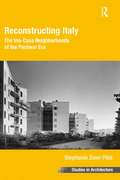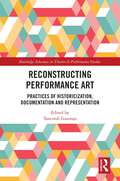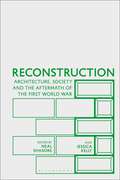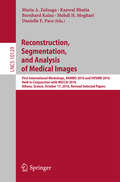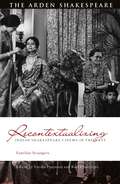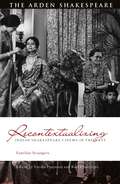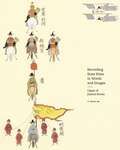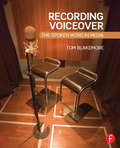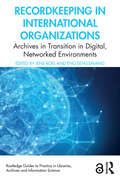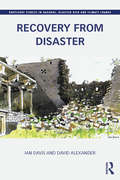- Table View
- List View
Reconstructing Historic Landmarks: Fabrication, Negotiation, and the Past (Routledge Research in Architectural Conservation and Historic Preservation)
by Wayde BrownHistoric reconstructions have been a consistent part of the historic preservation and heritage conservation movements in the United States and Canada. Indeed, reconstruction has been the primary tool at the most influential historic sites, for example: the Governor's Palace and the Capitol at Colonial Williamsburg, USA, and in Canada, the Fortress of Louisbourg. Dozens of other reconstructions have appeared during the past century in North America, undertaken by individuals, communities, states, and provinces, and by national agencies responsible for cultural heritage. Despite this prevalence, historic reconstructions have received little scholarly attention and the question of what motivated the proponents of these projects remains largely unexamined. This book explores that question through detailed studies of ten historic reconstructions located throughout Canada and the United States, ranging from 1908 to 2011. Drawing upon diverse archival sources and site investigations, the proponents of each site are given voice to address their need to remake these landmarks, be it to sustain, to challenge, or even subvert a historical narrative, or – with reference to contemporary heritage studies – to reclaim these spaces. Reconstructing Historic Landmarks provides a fascinating insight into these shifting concepts of history in North America and will be of considerable interest both to students and scholars of historic preservation and indeed to heritage professionals involved in reconstructions themselves.
Reconstructing Historic Landmarks: Fabrication, Negotiation, and the Past (Routledge Research in Architectural Conservation and Historic Preservation)
by Wayde BrownHistoric reconstructions have been a consistent part of the historic preservation and heritage conservation movements in the United States and Canada. Indeed, reconstruction has been the primary tool at the most influential historic sites, for example: the Governor's Palace and the Capitol at Colonial Williamsburg, USA, and in Canada, the Fortress of Louisbourg. Dozens of other reconstructions have appeared during the past century in North America, undertaken by individuals, communities, states, and provinces, and by national agencies responsible for cultural heritage. Despite this prevalence, historic reconstructions have received little scholarly attention and the question of what motivated the proponents of these projects remains largely unexamined. This book explores that question through detailed studies of ten historic reconstructions located throughout Canada and the United States, ranging from 1908 to 2011. Drawing upon diverse archival sources and site investigations, the proponents of each site are given voice to address their need to remake these landmarks, be it to sustain, to challenge, or even subvert a historical narrative, or – with reference to contemporary heritage studies – to reclaim these spaces. Reconstructing Historic Landmarks provides a fascinating insight into these shifting concepts of history in North America and will be of considerable interest both to students and scholars of historic preservation and indeed to heritage professionals involved in reconstructions themselves.
Reconstructing Italy: The Ina-Casa Neighborhoods of the Postwar Era
by Stephanie Zeier PilatReconstructing Italy traces the postwar transformation of the Italian nation through an analysis of the Ina-Casa plan for working class housing, established in 1949 to address the employment and housing crises. Government sponsored housing programs undertaken after WWII have often been criticized as experiments that created more social problems than they solved. The neighborhoods of Ina-Casa stand out in contrast to their contemporaries both in terms of design and outcome. Unlike modernist high-rise housing projects of the period, Ina-Casa neighborhoods are picturesque and human-scaled and incorporate local construction materials and methods resulting in a rich aesthetic diversity. And unlike many other government forays into housing undertaken during this period, the Ina-Casa plan was, on the whole, successful: the neighborhoods are still lively and cohesive communities today. This book examines what made Ina-Casa a success among so many failed housing experiments, focusing on the tenuous balance struck between the legislation governing Ina-Casa, the architects who led the Ina-Casa administration, the theory of design that guided architects working on the plan, and an analysis of the results-the neighborhoods and homes constructed. Drawing on the writings of the architects, government documents, and including brief passages from works of neorealist literature and descriptions of neorealist films by Pier Paolo Pasolini, Italo Calvino and others, this book presents a portrait of the postwar struggle to define a post-Fascist Italy.
Reconstructing Italy: The Ina-Casa Neighborhoods of the Postwar Era (Ashgate Studies In Architecture Ser.)
by Stephanie Zeier PilatReconstructing Italy traces the postwar transformation of the Italian nation through an analysis of the Ina-Casa plan for working class housing, established in 1949 to address the employment and housing crises. Government sponsored housing programs undertaken after WWII have often been criticized as experiments that created more social problems than they solved. The neighborhoods of Ina-Casa stand out in contrast to their contemporaries both in terms of design and outcome. Unlike modernist high-rise housing projects of the period, Ina-Casa neighborhoods are picturesque and human-scaled and incorporate local construction materials and methods resulting in a rich aesthetic diversity. And unlike many other government forays into housing undertaken during this period, the Ina-Casa plan was, on the whole, successful: the neighborhoods are still lively and cohesive communities today. This book examines what made Ina-Casa a success among so many failed housing experiments, focusing on the tenuous balance struck between the legislation governing Ina-Casa, the architects who led the Ina-Casa administration, the theory of design that guided architects working on the plan, and an analysis of the results-the neighborhoods and homes constructed. Drawing on the writings of the architects, government documents, and including brief passages from works of neorealist literature and descriptions of neorealist films by Pier Paolo Pasolini, Italo Calvino and others, this book presents a portrait of the postwar struggle to define a post-Fascist Italy.
Reconstructing Performance Art: Practices of Historicisation, Documentation and Representation (Routledge Advances in Theatre & Performance Studies)
by Tancredi GusmanThis book investigates the practices of reconstructing and representing performance art and their power to shape this art form and our understanding of it. Performance art emerged internationally between the 1960s and 1970s crossing disciplinary boundaries between performing arts and visual arts. Because of the challenge it posed to the ontologies and paradigms of these fields, performance art has since stimulated an ongoing debate on the most appropriate means to document, preserve and display it. Tancredi Gusman brings together international scholars from different disciplinary fields to examine methods, media, and approaches by which this art form has been represented and (re)activated over time and its transnational history reconstructed. Through contributions and case studies spanning various countries, regions and artistic fields, the authors outline an innovative theoretical-methodological framework for capturing the processes and strategies for transmitting the tangible and intangible heritage of performance art. This book will be of great appeal to students, researchers, and practitioners in the fields of Theatre and Performance Studies as well as Visual Arts and Art History, who have an interest in performance art, its history and presence in the contemporary artistic and cultural landscape.
Reconstructing Performance Art: Practices of Historicisation, Documentation and Representation (Routledge Advances in Theatre & Performance Studies)
This book investigates the practices of reconstructing and representing performance art and their power to shape this art form and our understanding of it. Performance art emerged internationally between the 1960s and 1970s crossing disciplinary boundaries between performing arts and visual arts. Because of the challenge it posed to the ontologies and paradigms of these fields, performance art has since stimulated an ongoing debate on the most appropriate means to document, preserve and display it. Tancredi Gusman brings together international scholars from different disciplinary fields to examine methods, media, and approaches by which this art form has been represented and (re)activated over time and its transnational history reconstructed. Through contributions and case studies spanning various countries, regions and artistic fields, the authors outline an innovative theoretical-methodological framework for capturing the processes and strategies for transmitting the tangible and intangible heritage of performance art. This book will be of great appeal to students, researchers, and practitioners in the fields of Theatre and Performance Studies as well as Visual Arts and Art History, who have an interest in performance art, its history and presence in the contemporary artistic and cultural landscape.
Reconstructing Shakespeare in the Nordic Countries: National Revival and Interwar Politics, 1870 – 1940 (Global Shakespeare Inverted)
by David Schalkwyk Silvia Bigliazzi Bi-qi Beatrice LeiExamining the changing reception of Shakespeare in the Nordic countries between 1870 and 1940, this follow-up volume to Disseminating Shakespeare in the Nordic Countries focuses on the broad movements of national revivalism that took place around the turn of the century as Finland and Norway, and later Iceland, were gaining their independence. The first part of the book demonstrates how translations and productions of Shakespeare were key in such movements, as Shakespeare was appropriated for national and political purposes. The second part explores how the role of Shakespeare in the Nordic countries was partly transformed in the 1920s and 1930s as a new social system emerged, and then as the rise of fascism meant that European politics cast a long shadow on the Nordic countries and substantially affected the reception of Shakespeare.Contributors trace the impact of early translations of Shakespeare's works into Icelandic, the role of women in the early transmission of Shakespeare in Finland and the first Shakespeare production at the Finnish Theatre, and the productions of Shakespeare's plays at the Norwegian National Theatre between 1899 and the outbreak of the Great War. In Part Two, they examine the political overtones of the 1916 Shakespeare celebrations in Hamlet's 'hometown' of Elsinore, Henrik Rytter's translations of 23 Shakespeare plays into Norwegian to assess their role in his poetics and in Scandinavian literature, the importance of the 1937 production of Hamlet in Kronborg Castle starring Laurence Olivier, and the role of Shakespeare in general and Hamlet in particular in Swedish Nobel laureate Eyvind Johnson's early work where it became a symbol of post-war passivity and rootlessness.
Reconstructing Shakespeare in the Nordic Countries: National Revival and Interwar Politics, 1870 – 1940 (Global Shakespeare Inverted)
by David Schalkwyk Silvia Bigliazzi Bi-qi Beatrice LeiExamining the changing reception of Shakespeare in the Nordic countries between 1870 and 1940, this follow-up volume to Disseminating Shakespeare in the Nordic Countries focuses on the broad movements of national revivalism that took place around the turn of the century as Finland and Norway, and later Iceland, were gaining their independence. The first part of the book demonstrates how translations and productions of Shakespeare were key in such movements, as Shakespeare was appropriated for national and political purposes. The second part explores how the role of Shakespeare in the Nordic countries was partly transformed in the 1920s and 1930s as a new social system emerged, and then as the rise of fascism meant that European politics cast a long shadow on the Nordic countries and substantially affected the reception of Shakespeare.Contributors trace the impact of early translations of Shakespeare's works into Icelandic, the role of women in the early transmission of Shakespeare in Finland and the first Shakespeare production at the Finnish Theatre, and the productions of Shakespeare's plays at the Norwegian National Theatre between 1899 and the outbreak of the Great War. In Part Two, they examine the political overtones of the 1916 Shakespeare celebrations in Hamlet's 'hometown' of Elsinore, Henrik Rytter's translations of 23 Shakespeare plays into Norwegian to assess their role in his poetics and in Scandinavian literature, the importance of the 1937 production of Hamlet in Kronborg Castle starring Laurence Olivier, and the role of Shakespeare in general and Hamlet in particular in Swedish Nobel laureate Eyvind Johnson's early work where it became a symbol of post-war passivity and rootlessness.
Reconstruction: Architecture, Society and the Aftermath of the First World War
by Neal Shasore and Jessica KellyReconstruction explores the impact of the First World War on the built environment – examining the immediate and longer term aftermath of the Great War on the architecture of Britain and the British Empire during the interwar years. While much attention has been paid by historians to post-war architectural reconstruction after 1945, the earlier developments of the interwar period (1919-1939) have been comparatively overlooked. This volume reveals how the architectural developments of this period not only provided important foundations for what happened after 1945 – they are also of real significance in their own right.Sixteen essays written by leading and emerging scholars bring together new and diverse approaches to the period – a period of reconstruction, fraught with the challenges of modernity and democratisation. The collection considers the complex effects of reconstruction on design, discourse, practice, and professionalism, and deals with the full spectrum of architectural styles and approaches, privileging neither Modernism nor traditional styles like the neo-Georgian. It brings to the fore social and political histories of the built environment, and makes important postcolonial interventions into the architectural history of British Imperialism at home and in its far reaches; in Cairo, South Africa, Australia, and India.
Reconstruction: Architecture, Society and the Aftermath of the First World War
Reconstruction explores the impact of the First World War on the built environment – examining the immediate and longer term aftermath of the Great War on the architecture of Britain and the British Empire during the interwar years. While much attention has been paid by historians to post-war architectural reconstruction after 1945, the earlier developments of the interwar period (1919-1939) have been comparatively overlooked. This volume reveals how the architectural developments of this period not only provided important foundations for what happened after 1945 – they are also of real significance in their own right.Sixteen essays written by leading and emerging scholars bring together new and diverse approaches to the period – a period of reconstruction, fraught with the challenges of modernity and democratisation. The collection considers the complex effects of reconstruction on design, discourse, practice, and professionalism, and deals with the full spectrum of architectural styles and approaches, privileging neither Modernism nor traditional styles like the neo-Georgian. It brings to the fore social and political histories of the built environment, and makes important postcolonial interventions into the architectural history of British Imperialism at home and in its far reaches; in Cairo, South Africa, Australia, and India.
Reconstruction and Analysis of 3D Scenes: From Irregularly Distributed 3D Points to Object Classes
by Martin WeinmannThis unique work presents a detailed review of the processing and analysis of 3D point clouds. A fully automated framework is introduced, incorporating each aspect of a typical end-to-end processing workflow, from raw 3D point cloud data to semantic objects in the scene. For each of these components, the book describes the theoretical background, and compares the performance of the proposed approaches to that of current state-of-the-art techniques. Topics and features: reviews techniques for the acquisition of 3D point cloud data and for point quality assessment; explains the fundamental concepts for extracting features from 2D imagery and 3D point cloud data; proposes an original approach to keypoint-based point cloud registration; discusses the enrichment of 3D point clouds by additional information acquired with a thermal camera, and describes a new method for thermal 3D mapping; presents a novel framework for 3D scene analysis.
Reconstruction and Restoration of Architectural Heritage 2021: Proceedings of 3rd International Conference on Reconstruction and Renovation of Architectural Heritage, March 24-27, 2021, Saint Petersburg, Russia
by Sergey SementsovReconstruction and Restoration of Architectural Heritage 2021 presents contributions on various aspects of the study, protection and restoration of architectural monuments and on the reconstruction of major historical urban development sites. Moreover, various complex and problematic aspects of engineering reconstruction of monuments are discussed. A wide range of issues is considered in the process of preserving historical heritage, including: the historical formation of buildings, construction and territories; the conservation, reconstruction and restoration of buildings and constructions; the transformation of historical spaces and areas. parallels and features in the development of urban planning, architecture and construction art in Russia and Spain the fate and work of Augustine Augustinovich Betancourt This collection of papers combines contributions about the history and restoration of many of the largest nature reserves, estates, cities and monuments. It is intended for academics and professionals involved in the history and restoration of nature reserves, estates, cities and monuments.
Reconstruction and Restoration of Architectural Heritage 2021: Proceedings of 3rd International Conference on Reconstruction and Renovation of Architectural Heritage, March 24-27, 2021, Saint Petersburg, Russia
by Sergey Sementsov Alexander Leontyev Huerta SantiagoReconstruction and Restoration of Architectural Heritage 2021 presents contributions on various aspects of the study, protection and restoration of architectural monuments and on the reconstruction of major historical urban development sites. Moreover, various complex and problematic aspects of engineering reconstruction of monuments are discussed. A wide range of issues is considered in the process of preserving historical heritage, including: the historical formation of buildings, construction and territories; the conservation, reconstruction and restoration of buildings and constructions; the transformation of historical spaces and areas. parallels and features in the development of urban planning, architecture and construction art in Russia and Spain the fate and work of Augustine Augustinovich Betancourt This collection of papers combines contributions about the history and restoration of many of the largest nature reserves, estates, cities and monuments. It is intended for academics and professionals involved in the history and restoration of nature reserves, estates, cities and monuments.
Reconstruction, Segmentation, and Analysis of Medical Images: First International Workshops, RAMBO 2016 and HVSMR 2016, Held in Conjunction with MICCAI 2016, Athens, Greece, October 17, 2016, Revised Selected Papers (Lecture Notes in Computer Science #10129)
by Maria A. Zuluaga Kanwal Bhatia Bernhard Kainz Mehdi H. Moghari Danielle F. PaceThis book constitutes the refereed proceedings of two workshops held at the 19th International Conference on Medical Image Computing and Computer-Assisted Intervention, MICCAI 2016, in Athens, Greece, in October 2016: the First International Workshop on Reconstruction and Analysis of Moving Body Organs, RAMBO 2016, and the First International Workshop on Whole-Heart and Great Vessel Segmentation from 3D Cardiovascular MRI in Congenital Heart Disease, HVSMR 2016. The 17 revised regular papers presented in this book were carefully reviewed and selected from a total of 21 submissions. The papers cover following topics: Registration; Reconstruction; Deep learning for heart segmentation; Discrete optimization and probabilistic intensity modeling; Atlas-based strategies; Random forests.
Recontextualizing Indian Shakespeare Cinema in the West: Familiar Strangers (Global Shakespeare Inverted)
by David Schalkwyk Silvia Bigliazzi Bi-qi Beatrice LeiFeaturing case studies, essays, and conversation pieces by scholars and practitioners, this volume explores how Indian cinematic adaptations outside the geopolitical and cultural boundaries of India are revitalizing the broader landscape of Shakespeare research, performance, and pedagogy. Chapters in this volume address practical and thematic concerns and opportunities that are specific to studying Indian cinematic Shakespeares in the West. For instance, how have intercultural encounters between Indian Shakespeare films and American students inspired new pedagogic methodologies? How has the presence and popularity of Indian Shakespeare films affected policy change at British cultural institutions? How can disagreement between eastern and western perspectives on the politics of a Shakespeare film become the site for productive cross-cultural dialogue? This is the first book to explore such complex interactions between Indian Shakespeare films and Western audiences to contribute to the assessment of the new networks that have emerged as a result of Global Shakespeare studies and practices. The volume argues that by tracking critical currents from India towards the West new insights are afforded on the wider field of Shakespeare Studies - including feminist Shakespeares, translation in Shakespeare, or the study of music in Shakespeare - and are shaping debates on the ownership and meaning of Shakespeare itself. Contributing to the current studies in Global Shakespeare, this book marks a discursive shift in the way Shakespeare on Indian screen is predominantly theorised and offers an alternative methodology for examining non-Anglophone cinematic Shakespeares as a whole.
Recontextualizing Indian Shakespeare Cinema in the West: Familiar Strangers (Global Shakespeare Inverted)
by David Schalkwyk Silvia Bigliazzi Bi-qi Beatrice LeiFeaturing case studies, essays, and conversation pieces by scholars and practitioners, this volume explores how Indian cinematic adaptations outside the geopolitical and cultural boundaries of India are revitalizing the broader landscape of Shakespeare research, performance, and pedagogy. Chapters in this volume address practical and thematic concerns and opportunities that are specific to studying Indian cinematic Shakespeares in the West. For instance, how have intercultural encounters between Indian Shakespeare films and American students inspired new pedagogic methodologies? How has the presence and popularity of Indian Shakespeare films affected policy change at British cultural institutions? How can disagreement between eastern and western perspectives on the politics of a Shakespeare film become the site for productive cross-cultural dialogue? This is the first book to explore such complex interactions between Indian Shakespeare films and Western audiences to contribute to the assessment of the new networks that have emerged as a result of Global Shakespeare studies and practices. The volume argues that by tracking critical currents from India towards the West new insights are afforded on the wider field of Shakespeare Studies - including feminist Shakespeares, translation in Shakespeare, or the study of music in Shakespeare - and are shaping debates on the ownership and meaning of Shakespeare itself. Contributing to the current studies in Global Shakespeare, this book marks a discursive shift in the way Shakespeare on Indian screen is predominantly theorised and offers an alternative methodology for examining non-Anglophone cinematic Shakespeares as a whole.
The Recording Machine: Art and Fact during the Cold War
by Joshua ShannonA revealing look at the irrevocable change in art during the 1960s and its relationship to the modern culture of fact This refreshing and erudite book offers a new understanding of the transformation of photography and the visual arts around 1968. Author Joshua Shannon reveals an oddly stringent realism in the period, tracing artists’ rejection of essential truths in favor of surface appearances. Dubbing this tendency factualism, Shannon illuminates not only the Cold War’s preoccupation with data but also the rise of a pervasive culture of fact. Focusing on the United States and West Germany, where photodocumentary traditions intersected with 1960s politics, Shannon investigates a broad variety of art, ranging from conceptual photography and earthworks to photorealist painting and abstraction. He looks closely at art by Bernd and Hilla Becher, Robert Bechtle, Vija Celmins, Douglas Huebler, Gerhard Richter, and others. These artists explored fact’s role as a modern paradigm for talking, thinking, and knowing. Their art, Shannon concludes, helps to explain both the ambivalent anti-humanism of today’s avant-garde art and our own culture of fact.
Recording State Rites in Words and Images: Uigwe of Joseon Korea (Publications Of The Tang Center For East Asian Art, Princeton University Ser. #16)
by Yi Song-miA beautifully illustrated, interdisciplinary look at the ceremonies and protocols of the dynastic court of Joseon KoreaRecording State Rites in Words and Images provides an engaging and in-depth exploration of the large corpus of court statutes compiled during the Joseon dynasty of Korea. The term uigwe, commonly translated as &“royal protocols,&” is the name given to the collection of nearly four thousand books that were commissioned and written to document the customs, rituals, rules, protocols, and ceremonial practices of the Joseon dynasty. In this generously illustrated book, Yi Song-mi introduces readers to the rich and varied documentary tradition embodied in the uigwe, sharing invaluable insights into time-honored court customs through text and images and analyzing changes in ritual practice over time.The first comprehensive study of its kind in English, Recording State Rites in Words and Images presents groundbreaking research that opens a window on Korean history and art and will serve as an inspiration to students, scholars, and anyone interested in topics such as dynastic customs, court artists, and bookmaking.Published in association with the P. Y. and Kinmay W. Tang Center for East Asian Art at Princeton University
Recording Voiceover: The Spoken Word in Media
by Tom BlakemoreThe only book on the market to specifically address its audience, Recording Voiceover is the comprehensive guide for engineers looking to understand the aspects of capturing the spoken word. Discussing all phases of the recording session, Recording Voiceover addresses everything from microphone recommendations for voice recording to pre-production considerations, including setting up the studio, working with and directing the voice talent, and strategies for reducing or eliminating distracting noise elements found in human speech. Recording Voiceover features in-depth, specific recommendations for recording radio and television commercials, corporate communications, documentaries, tracks for gaming and animation, radio drama, interviews and roundtable discussions. A discussion of the voice in film and television is also included. Special attention is paid to the final release format and its impact on recording strategies. Exploration of using telephone interfaces – including both analogue and digital ISDN, as well as recording across the internet – is included.
Recording Voiceover: The Spoken Word in Media
by Tom BlakemoreThe only book on the market to specifically address its audience, Recording Voiceover is the comprehensive guide for engineers looking to understand the aspects of capturing the spoken word. Discussing all phases of the recording session, Recording Voiceover addresses everything from microphone recommendations for voice recording to pre-production considerations, including setting up the studio, working with and directing the voice talent, and strategies for reducing or eliminating distracting noise elements found in human speech. Recording Voiceover features in-depth, specific recommendations for recording radio and television commercials, corporate communications, documentaries, tracks for gaming and animation, radio drama, interviews and roundtable discussions. A discussion of the voice in film and television is also included. Special attention is paid to the final release format and its impact on recording strategies. Exploration of using telephone interfaces – including both analogue and digital ISDN, as well as recording across the internet – is included.
Recording Women: A Documentation of Six Theatre Productions (Routledge Revivals)
by Geraldine CousinFirst Published in 2000, Recording Women documents the work of three leading feminist theatre companies, Sphinx Theatre Company, Scarlett Theatre and Foresight Theatre, through a combination of interviews with theatre practitioners and detailed descriptions of productions in performance. Each of the six productions is innovative in content and style.Scarlett Theatre’s Paper Walls and Foresight Theatre’s Boadicea: The Red-Bellied Queen employ a skillful mixture of text, music, physical performance, humour and seriousness to explore, respectively, domestic abuse and rape (of women and community). Scarlett Theatre’s The Sisters and Sphinx’s Voyage in the Dark adapt existing texts. The sisters is a ritualized re-enactment of Chekhov’s Three Sisters in which only the female characters from the play appear. Voyage in the Dark uses film-noir-like theatrical effects and the insistent rhythms of the tango to evoke the rootlessness and sense of alienation that characterizes Jean Rhys’s novel. Slap (Foursight Theatre) and Goliath (Sphinx) are both one woman shows. Slap, performed by Naomi Cooke, explores images of motherhood, including lesbian motherhood and the concept of virgin birth. Goliath, performed by Nicola McAuliffe, is a dramatization, by Bryony Lavery, of Beatrix Campbell’s powerful study of the 1991 riots in Cardiff, Oxford and Tyneside. This is a must read for scholars and researchers of theatre studies.
Recording Women: A Documentation of Six Theatre Productions (Routledge Revivals)
by Geraldine CousinFirst Published in 2000, Recording Women documents the work of three leading feminist theatre companies, Sphinx Theatre Company, Scarlett Theatre and Foresight Theatre, through a combination of interviews with theatre practitioners and detailed descriptions of productions in performance. Each of the six productions is innovative in content and style.Scarlett Theatre’s Paper Walls and Foresight Theatre’s Boadicea: The Red-Bellied Queen employ a skillful mixture of text, music, physical performance, humour and seriousness to explore, respectively, domestic abuse and rape (of women and community). Scarlett Theatre’s The Sisters and Sphinx’s Voyage in the Dark adapt existing texts. The sisters is a ritualized re-enactment of Chekhov’s Three Sisters in which only the female characters from the play appear. Voyage in the Dark uses film-noir-like theatrical effects and the insistent rhythms of the tango to evoke the rootlessness and sense of alienation that characterizes Jean Rhys’s novel. Slap (Foursight Theatre) and Goliath (Sphinx) are both one woman shows. Slap, performed by Naomi Cooke, explores images of motherhood, including lesbian motherhood and the concept of virgin birth. Goliath, performed by Nicola McAuliffe, is a dramatization, by Bryony Lavery, of Beatrix Campbell’s powerful study of the 1991 riots in Cardiff, Oxford and Tyneside. This is a must read for scholars and researchers of theatre studies.
Recordkeeping in International Organizations: Archives in Transition in Digital, Networked Environments (Routledge Guides to Practice in Libraries, Archives and Information Science)
by Jens Boel Eng SengsavangRecordkeeping in International Organizations offers an important treatment of international organizations from a recordkeeping perspective, while also illustrating how recordkeeping can play a vital role in our efforts to improve global social conditions.Demonstrating that organizations have both a responsibility and an incentive to effectively manage their records in order to make informed decisions, remain accountable to stakeholders, and preserve institutional history, the book offers practical insights and critical reflections on the effective management, protection, and archiving of records. Through policy advice, surveys, mind mapping, case studies, and strategic reflections, the book provides guidance in the areas of archives, records, and information management for the future. Among the topics addressed are educational requirements for recordkeeping professionals, communication policies, data protection and privacy, cloud computing, classification and declassification policies, artificial intelligence, risk management, enterprise architecture, and the concepts of extraterritoriality and inviolability of archives. The book also offers perspectives on how digital recordkeeping can support the UN’s 2030 Agenda for Sustainable Development, and the accompanying Sustainable Development Goals (SDGs).Recordkeeping in International Organizations will be essential reading for records and archives professionals, information technology, legal, security, management, and leadership staff, including chief information officers. The book should also be of interest to students and scholars engaged in the study of records, archives, and information management, information technology, information security, and law.Chapters 7 and 9 of this book are freely available as a downloadable Open Access PDF at http://www.taylorfrancis.com under a Attribution-NonCommercial-ShareAlike (CC-BY-NC-SA) 4.0 license
Recordkeeping in International Organizations: Archives in Transition in Digital, Networked Environments (Routledge Guides to Practice in Libraries, Archives and Information Science)
by Jens Boel Eng SengsavangRecordkeeping in International Organizations offers an important treatment of international organizations from a recordkeeping perspective, while also illustrating how recordkeeping can play a vital role in our efforts to improve global social conditions.Demonstrating that organizations have both a responsibility and an incentive to effectively manage their records in order to make informed decisions, remain accountable to stakeholders, and preserve institutional history, the book offers practical insights and critical reflections on the effective management, protection, and archiving of records. Through policy advice, surveys, mind mapping, case studies, and strategic reflections, the book provides guidance in the areas of archives, records, and information management for the future. Among the topics addressed are educational requirements for recordkeeping professionals, communication policies, data protection and privacy, cloud computing, classification and declassification policies, artificial intelligence, risk management, enterprise architecture, and the concepts of extraterritoriality and inviolability of archives. The book also offers perspectives on how digital recordkeeping can support the UN’s 2030 Agenda for Sustainable Development, and the accompanying Sustainable Development Goals (SDGs).Recordkeeping in International Organizations will be essential reading for records and archives professionals, information technology, legal, security, management, and leadership staff, including chief information officers. The book should also be of interest to students and scholars engaged in the study of records, archives, and information management, information technology, information security, and law.Chapters 7 and 9 of this book are freely available as a downloadable Open Access PDF at http://www.taylorfrancis.com under a Attribution-NonCommercial-ShareAlike (CC-BY-NC-SA) 4.0 license
Recovery from Disaster (Routledge Studies in Hazards, Disaster Risk and Climate Change)
by David Alexander Ian DavisDisasters can dominate newspaper headlines and fill our TV screens with relief appeals, but the complex long-term challenge of recovery—providing shelter, rebuilding safe dwellings, restoring livelihoods and shattered lives—generally fails to attract the attention of the public and most agencies. On average 650 disasters occur each year. They affect more than 200 million people and cause $166 trillion of damage. Climate change, population growth and urbanisation are likely to intensify further the impact of natural disasters and add to reconstruction needs. Recovery from Disaster explores the field and provides a concise, comprehensive source of knowledge for academics, planners, architects, engineers, construction managers, relief and development officials and reconstruction planners involved with all sectors of recovery, including shelter and rebuilding. With almost 80 years of first-hand experience of disaster recovery between them, Ian Davis (an architect) and David Alexander (a geographer) draw substantially from first-hand experiences in a variety of recovery situations in China, Haiti, Italy, Japan, New Zealand, Pakistan, the Philippines and the USA. The volume is further enriched by two important and unique features: 21 models of disaster recovery are presented, seven of which were specifically developed for the book. The second feature is a survey of expert opinion about the nature of effective disaster recovery—the first of its kind. More than 50 responses are provided in full, along with an analysis that integrates them with the theories that underpin them. By providing a framework and models for future study and applications, Davis and Alexander seek both to advance the field and to provide a much-needed reference work for decision makers. With a broad perspective derived from the authors' roles held as university professors, researchers, trainers, consultants, NGO directors and advisors to governments and UN agencies, this comprehensive guide will be invaluable for practitioners and students of disaster management.

